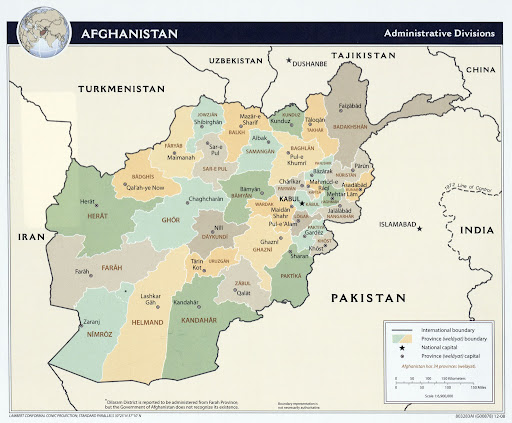The Box Office will be open for phone service only today, Monday, April 29 and will be closing at 3PM. We will resume normal hours on Tuesday, April 30
Afghanistan, The Heart of Asia

Map of Afghanistan by Gerald G. Coleman
Afghanistan’s beautiful snow-capped mountains, lush green valleys, icy-cold rivers, and bustling bazaars have been the backdrop for the country’s diverse history and culture. Its strategic location in the heart of Asia has allowed caravans of nomads, merchants, poets, artists, and musicians to flow through and settle within the arteries of Afghan civilization. The rich and diverse heritage of Afghans is reflected in the poems of Rabia Balkhi, the miniature arts of Herat, the handcrafted pottery of Istalif, and Mes Aynak cultural heritage site, where a large complex of Buddhist monasteries, homes, markets and over 400 statues of Buddha were excavated.
Afghanistan’s cultural diversity is well and alive in the fourteen main ethnic groups, each with their own unique customs, languages, cultural and religious practices. However, one custom common among all Afghans is the pride and honor that goes into hosting guests. Whether it’s the Eid holiday, Nowroz celebration, an engagement party, a lavish wedding, or carpet store chit-chat, all hosting starts with a cup of tea.
Tea and Mehman Nawazee, Hospitality
Hospitality and tea play an important part in the lives of the Afghan people. From the first light of the day until the wee hours of the night, an Afghan home’s teapot or thermos is never empty.
It doesn’t matter what time of the day you arrive at an Afghan home, announced or unannounced, within minutes a cup of tea–black or green–is served with a platter or dried fruit, hard candy, noqul (sugar covered almonds or chickpeas) or pastries. The teacup will be refilled over and over, until you cover the top of the teacup with your hand or turn the teacup upside down, to stop the host/ess from executing the next refill. If you are visiting within a three-hour window of the next meal, you can be sure that while you enjoy tea, there will be one or two people in the kitchen working on the most elaborate meal the family can afford. Sometimes the host’s spending on guests, especially for weddings and engagement parties, can put a family into financial debt but that is more acceptable than losing face for not honoring your guests properly.
Afghan hospitality is world famous, unless you show up with an occupying army. Any visit to an Afghan home starts and ends with tea. To learn more about Afghan food, culture, and how to make the best cup of chai, Afghan cardamom tea, go to Afghan Culture Unveiled
Afghanistan Fast Facts
Population:
38,920,647
Official Languages:
Pashto and Dari
People:
47.7% under the age of 15
27% between the age of 15-90
Religions:
Islam – 84.7% Sunni and 15% Shia
Main Ethnicities
Pashtun, Tajik, Hazara, Uzbek, Aimaq, Turkmen, Baluch, Nuristani, Pamiri, Arab, Gujar, Brahui, Qizilbash and Pashai
Literacy Rate
38.2% Literate Overall (2020)
52% (Male 2015)
24.2% (Female 2015)
Did you know?
- The people of Afghanistan are called Afghans and the currency is called Afghani.
- More than 90% of Afghanistan has cell phone coverage and there are 22 million cell phone subscribers.
- 78% of Afghans work in agriculture.
- Afghanistan produces some of the world’s finest pomegranates, grapes, apricots and melons.
- The world’s first oil paintings were drawn around 650 BC in the caves of Bamiyan, in the central highlands of Afghanistan.
- Poetry writing, recitation, and competition (a.k.a. shayr jangee), is a revered pastime in Afghanistan.
You can find out more about the author, Humaira Ghilzai, on her website: humairaghilzai.com.